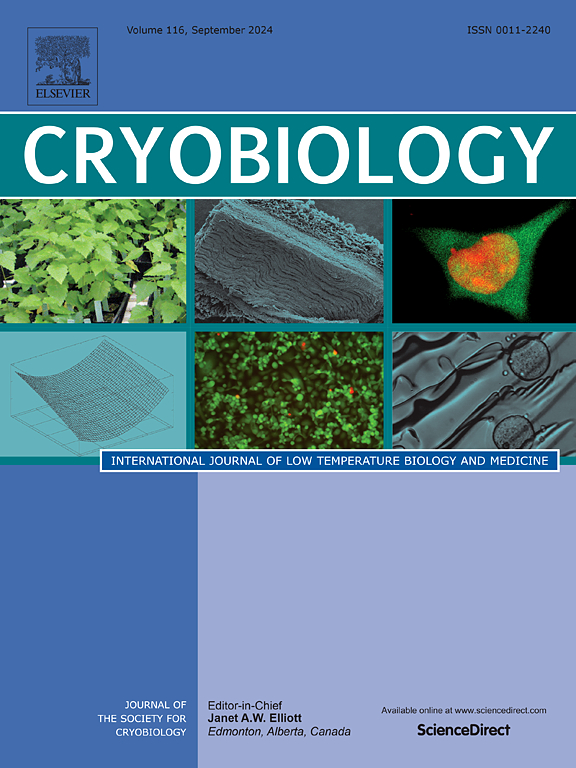Taxifolin: A flavonoid in the freezing medium augments post-thaw semen quality and in vivo fertility potential of buffalo bull spermatozoa
IF 2.3
3区 生物学
Q2 BIOLOGY
引用次数: 0
Abstract
This comprehensive study was carried out to investigate the effects of taxifolin in the freezing medium on post-thaw semen quality, and fertility potential of buffalo bull spermatozoa. Taxifolin was also evaluated for radical scavenging activity through DPPH (2, 2-diphenyl-1-picrylhydrazyl), and Nitric oxide (NO) inhibition (%) during in vitro conditions. Collected semen samples from four buffalo bulls were initially evaluated (consistency, volume, motility, and concentrations); the accepted samples were pooled, and diluted in extenders containing different doses of taxifolin (0 μM [control], 2 μM, 5 μM, 10 μM, and 20 μM). Diluted semen was gradually cooled (2 h, 4 °C), equilibrated (4 h, 4 °C), and then frozen in liquid nitrogen (−196 °C). Data analysis revealed that taxifolin supplementation (10 μM) displayed the highest DPPH-scavenging ability, and NO inhibition compared to the control (% DPPH, 67.31 vs. 13.50; and % NO, 78.25 vs. 21.25) respectively. Moreover, taxifolin supplementation (10 μM) significantly (P < 0.05) improved progressive motility (%), average path velocity (μm/sec), straight-line velocity (μm/sec), and seminal plasma glutathione peroxidase (μM), and superoxide dismutase (U/mL) of buffalo bull spermatozoa than control. Sperm plasma membrane integrity, mitochondrial transmembrane potential, acrosome integrity (%) and seminal plasma adenosine triphosphate (nmol/million), and total antioxidant capacity (μM/L) were enhanced significantly with taxifolin (10 and 20 μM) supplementing group. Lastly, taxifolin supplementation significantly improved the fertility rate (%, 69.09 vs. 40.38) compared to the control. Further studies to assess mechanisms by which taxifolin improves semen quality and fertility of buffalo spermatozoa are warranted.
Taxifolin:冷冻培养基中的一种黄酮类化合物,可提高水牛精子解冻后的精液质量和体内生育潜力。
这项综合研究旨在探讨冷冻培养基中的紫杉叶素对水牛精子解冻后精液质量和生育潜力的影响。研究还通过 DPPH(2, 2-二苯基-1-苦基肼)和一氧化氮(NO)在体外条件下的抑制率来评估 Taxifolin 的自由基清除活性。对从四头水牛身上采集的精液样本进行初步评估(一致性、体积、运动性和浓度);将接受的样本集中起来,并在含有不同剂量(0 μM[对照组]、2 μM、5 μM、10 μM 和 20 μM)taxifolin 的扩展剂中稀释。稀释后的精液逐渐冷却(2 小时,4°C),平衡(4 小时,4°C),然后冷冻在液氮中(-196°C)。数据分析结果表明,与对照组相比,补充紫杉叶素(10 μM)的 DPPH 清除能力和 NO 抑制能力最高(DPPH 抑制率分别为 67.31% vs. 13.50;NO 抑制率分别为 78.25% vs. 21.25)。此外,与对照组相比,补充紫杉叶素(10 μM)能显著(P < 0.05)提高水牛精子的渐进运动率(%)、平均路径速度(μm/秒)、直线速度(μm/秒)、精浆谷胱甘肽过氧化物酶(μM)和超氧化物歧化酶(U/mL)。水牛精子的精浆膜完整性、线粒体跨膜电位、顶体完整性(%)、精浆三磷酸腺苷(nmol/million)和总抗氧化能力(μM/L)在补充紫杉叶素(10 和 20 μM)组有显著提高。最后,与对照组相比,补充 taxifolin 能显著提高受精率(%,69.09 vs. 40.38)。有必要开展进一步研究,以评估 taxifolin 改善水牛精液质量和生育能力的机制。
本文章由计算机程序翻译,如有差异,请以英文原文为准。
求助全文
约1分钟内获得全文
求助全文
来源期刊

Cryobiology
生物-生理学
CiteScore
5.40
自引率
7.40%
发文量
71
审稿时长
56 days
期刊介绍:
Cryobiology: International Journal of Low Temperature Biology and Medicine publishes research articles on all aspects of low temperature biology and medicine.
Research Areas include:
• Cryoprotective additives and their pharmacological actions
• Cryosurgery
• Freeze-drying
• Freezing
• Frost hardiness in plants
• Hibernation
• Hypothermia
• Medical applications of reduced temperature
• Perfusion of organs
• All pertinent methodologies
Cryobiology is the official journal of the Society for Cryobiology.
 求助内容:
求助内容: 应助结果提醒方式:
应助结果提醒方式:


